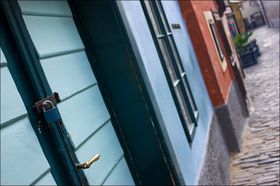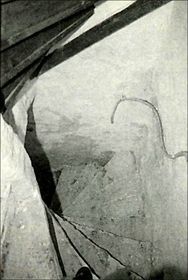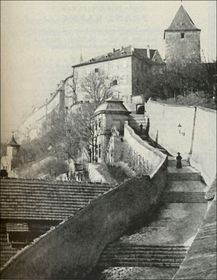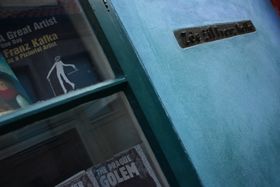Golden Lane 22, Prague Castle
 One of the most well-known Kafka sites is the little house in the Golden Lane No. 22 in the Prague Castle. The lane, also called Alchemists’ Lane or Goldmakers’ Lane, was laid out at the end of the 16th century. In 1594 Emperor Rudolf II permitted 24 marksmen to build a settlement in the recesses of the northern fortress wall. Soon a village life must have developed there since the inhabitants built small stalls and pens to house animals, let chickens scratch around in the mud and transformed the street into the sort of canal. It wasn’t until 19th century that conditions improved and the narrow lane took on its present appearance. Under the pressure of the castle administration the last inhabitants had to leave the lane in the 1950s.
One of the most well-known Kafka sites is the little house in the Golden Lane No. 22 in the Prague Castle. The lane, also called Alchemists’ Lane or Goldmakers’ Lane, was laid out at the end of the 16th century. In 1594 Emperor Rudolf II permitted 24 marksmen to build a settlement in the recesses of the northern fortress wall. Soon a village life must have developed there since the inhabitants built small stalls and pens to house animals, let chickens scratch around in the mud and transformed the street into the sort of canal. It wasn’t until 19th century that conditions improved and the narrow lane took on its present appearance. Under the pressure of the castle administration the last inhabitants had to leave the lane in the 1950s.
 Kafka and his sister had gone around this place in the middle of 1916. For Kafka it meant a lot to live in the house not only in the room. “Today it suits me completely. In every way: the beautiful path leading up there, the silence there, only a thin wall separates me from a neighbor, but that neighbor is quiet enough; I carry my supper up there and am usually there until midnight; then the advantage of the way home: I have to decide to stop, I then have a walk that will cool my head. And life there: it’s something special, to have one’s own house, to lock the door on the world, not the door of a room, not that of an apartment, but actually the door of a house, to step out the door of your living quarters into the snow in the silent street. The whole thing twenty crowns per month, furnished by my sister with everything necessary, looked after as little as needs be by the little flower girl, everything in order and nice.”
Kafka and his sister had gone around this place in the middle of 1916. For Kafka it meant a lot to live in the house not only in the room. “Today it suits me completely. In every way: the beautiful path leading up there, the silence there, only a thin wall separates me from a neighbor, but that neighbor is quiet enough; I carry my supper up there and am usually there until midnight; then the advantage of the way home: I have to decide to stop, I then have a walk that will cool my head. And life there: it’s something special, to have one’s own house, to lock the door on the world, not the door of a room, not that of an apartment, but actually the door of a house, to step out the door of your living quarters into the snow in the silent street. The whole thing twenty crowns per month, furnished by my sister with everything necessary, looked after as little as needs be by the little flower girl, everything in order and nice.”
 Old Castle Stairs
The little house was just a small living room with a small window looking out onto the green Stag Moat, between the entrance door and the living room a tiny vestibule with two passages leading through, one up to the attic, the other over stone steps into the cellar vault. Down there the castle administration had an alchemist’s laboratory set up for show in the fifties with a place to make fire, with pipettes, glass bulbs and similar things, after the previous owner Anežka Michlová, a laundry woman and kitchen assistant in the Lobkowicz Palace, had been forced to sell the small but even then already valuable property. Originally only the little house number 20 had belonged to her, but when she married a certain Bohumil Michl during the First World War, she also became the owner of house number 22 which she was able to rent to Ottla. From May 1917 on the married couple Michl lived in the house No. 20 in the immediate neighborhood of Kafka. Kafka usually spent the evening hours in the tiny little house, after he had done his day’s work and also had taken his supper. He could not stay in the small, ill-equipped room, however. Thus he usually went away in the early morning hours or towards “midnight down to the city by way of the Old Castle Stairs”.
Old Castle Stairs
The little house was just a small living room with a small window looking out onto the green Stag Moat, between the entrance door and the living room a tiny vestibule with two passages leading through, one up to the attic, the other over stone steps into the cellar vault. Down there the castle administration had an alchemist’s laboratory set up for show in the fifties with a place to make fire, with pipettes, glass bulbs and similar things, after the previous owner Anežka Michlová, a laundry woman and kitchen assistant in the Lobkowicz Palace, had been forced to sell the small but even then already valuable property. Originally only the little house number 20 had belonged to her, but when she married a certain Bohumil Michl during the First World War, she also became the owner of house number 22 which she was able to rent to Ottla. From May 1917 on the married couple Michl lived in the house No. 20 in the immediate neighborhood of Kafka. Kafka usually spent the evening hours in the tiny little house, after he had done his day’s work and also had taken his supper. He could not stay in the small, ill-equipped room, however. Thus he usually went away in the early morning hours or towards “midnight down to the city by way of the Old Castle Stairs”.
 In this house a whole series of prose pieces and fragments came into existence from the late fall of 1916 on, among others almost all the stories that appeared in 1920 in the collection A Country Doctor. Kafka’s name was still only known to a small, dedicated group of readers and so successful sales figures remain absent. In the summer of 1917 the owner Anežka Michlová revoked the lease, which hardly perturbed the occupant whose tuberculosis had just made itself known: „But better this way, perhaps I couldn’t have been in the damp little house at all.“
In this house a whole series of prose pieces and fragments came into existence from the late fall of 1916 on, among others almost all the stories that appeared in 1920 in the collection A Country Doctor. Kafka’s name was still only known to a small, dedicated group of readers and so successful sales figures remain absent. In the summer of 1917 the owner Anežka Michlová revoked the lease, which hardly perturbed the occupant whose tuberculosis had just made itself known: „But better this way, perhaps I couldn’t have been in the damp little house at all.“
